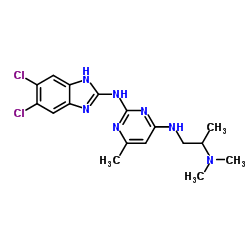
33069-62-4
- Product Name:Paclitaxel
- Molecular Formula:C47H51NO14
- Purity:99%
- Molecular Weight:853.92
Product Details:
CasNo: 33069-62-4
Molecular Formula: C47H51NO14
Purity: 99%
Synonyms: Paclitaxel HCL; Paclitaxel(natural crude); Paclitaxelx; N-BENZYL-BETA-PHENYLISOSERINE ESTER; PACLITAXEL,TAXUS BREVIFOLIA; PACLITAXEL,TAXUS SPECIES; PACLITAXOL; PACLITAXEL
Melting point: 213 °C (dec.)(lit.)
Alpha: D20 -49° (methanol)
Boiling point: 774.66°C (rough estimate)
Density: 0.200
Refractive index: -49 ° (C=1, MeOH)
Fp: 9℃
Solubility: methanol: 50 mg/mL, clear, colorless
Form: powder
Pka: 11.90±0.20(Predicted)
Color: white
Water Solubility: 0.3mg/L(37 ºC)
Melting point: 213 °C (dec.)(lit.)
Alpha: D20 -49° (methanol)
Boiling point: 774.66°C (rough estimate)
Density: 0.200
Refractive index: -49 ° (C=1, MeOH)
Fp: 9℃
Solubility: methanol: 50 mg/mL, clear, colorless
Form: powder
Pka: 11.90±0.20(Predicted)
Color: white
Water Solubility: 0.3mg/L(37 ºC)
Description:
Paclitaxel, a natural product isolated from the bark of the Pacific yew, is effective in treating refractory metastatic ovarian cancer. Unlike any other antineoplastic agents, paclitaxel appears to have several possible mechanisms of action, including an antimicrotubule action through the promotion of tubulin polymerization and stabilization of microtubules, thereby, halting mitosis and promoting cell death. The supply of paclitaxel is limited by its low natural abundance and currently it is being manufactured by a semi-synthetic route from deacetylbaccatin Ⅲ that is isolated from the needles of the yew tree. Recent completion of two total syntheses of taxol conquered the structural complexity of the title compound and may be useful in obtaining certain closely related analogs, some of which have been found to have antitumor activity. Paclitaxel has potential uses in the treatment of metastatic breast cancer, lung cancer, head and neck cancer, and malignant melanoma.
History:
The toxic ingredients in branches and leaves of Taxus chinensis were separated in 1856 and named “taxine,” which was identified as a kind of white alkaloid’s component. Currently, among all the antitumor drugs, the sale of paclitaxel becomes the first in the world as a well-recognized anticancer drug with potent broad-spectrum activity. In October of 1995, China became the second country with formal production of paclitaxel and its injection in the world. The achievement was gained under the unremitting efforts of researchers in the Institute of Materia Medica, Chinese Academy of Medical Sciences.
Uses:
Paclitaxel is an antineoplastic that used to treat patients with lung, ovarian, breast cancer, head and neck cancer, and advanc ed forms of Kaposi's sarcoma. Paclitaxel is a mitotic inhibitor used in cancer chemotherapy. It is also used in the study of structure and function of microtubles into tubulin.
General Description:
Paclitaxel (commercial name, Taxol) a complex diterpene alkaloid isnaturally obtained from Taxus species (family Taxaceae). Paclitaxel has been provedas highly effective in the treatment of various types of cancers, since it acts as amicrotubule-stabilizing agent to protect against disassembly. Paclitaxel was developed by the National Cancer Institute, USA, as a drug for cancer therapy andused for the treatment of refractory ovarian cancer, metastatic breast and lung cancer,and Kaposi’s sarcoma (Srivastava et al. 2005). The natural source of paclitaxelis the bark of several Taxus species; however, the cost of extraction is very highsince the concentration of paclitaxel accumulation is very low (0.02% of dry weight)and also entails the destruction of natural resources (Cusido et al. 2014). Eventhough, paclitaxel can be chemically synthesized, but this process is not commerciallyviable. Plant cell cultures have been developed for the production of paclitaxelby Phyton Biotech in 1995, and in 2004 the FDA has approved the use of plantculture supply of paclitaxel/Taxol (Leone and Roberts 2013).
Pharmacology:
Paclitaxel is mainly used for the treatment of ovarian cancer and breast cancer. The mechanism of it includes:
1. The effects on cell microtubules/tubulin: Inhibition of microtubule depolymerization results in abnormal micro tube bundle arrangement and makes the spindle lose normal function and then induces cell death.
2. In the absence of bird triphosphate (GTP) and microtubule associated protein (MAP), it induces cells to form microtubule lack of function.
3. It significantly sensitized cancer cells to radiotherapy through blocking the cell cycle in the stage of G2 and M .
Paclitaxel is mainly metabolized through the liver and enters into the intestine with bile and then eliminated from the body by the feces (90%).
Relevant Products
-
Apixaban
CAS:503612-47-3
-
Betulinic acid
CAS:472-15-1
-
Ipilimumab
CAS:477202-00-9








